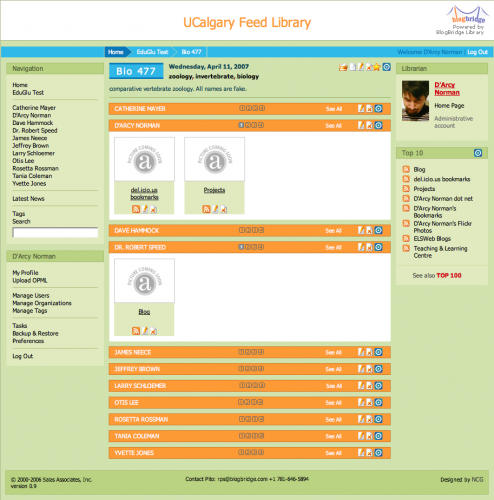I had a discussion with King Chung Huang and Paul Pival this morning, about one of King’s current research projects. He’s working on the topic of context and identity – what it would mean from both institutional and individual perspectives, if our digital identities and contexts were pulled out of the silos of Blackboard, email, and other isolated and closed systems. What would it mean if every person, group, and place has a URL, which is aware of contexts (institutional, academic, geographical, temporal, etc…) and is also able to gather and provide lists of relevant resources.
A Person would have what is essentially a profile (name, role, contact info, interests, courses, websites, etc…), a Group would describe its type (department, faculty, course, session, club, etc…) as well as lists of relevant bits of info (uses a wiki, has a Blackboard course, meets at this location at this time, has these members, etc…). And Places would describe physical locations, knowing which resources are available, where they are, which Persons and Groups are interested in the Place, as well as scheduling information, etc… (hmm… do we need a fourth primitive type of Time?)
At first blush, it felt like a “portal” problem. Set up a personal Pageflakes or Netvibes page, dropping in some relevant widgets and links. Everyone can customize their own page, and a directory could be created to help discover people, groups, and places.
But that approach loses any real meaning of the contexts. It’s just a dumb content display utility, without being aware of the meaning of the contexts of the content, or of the relationships between people, groups and places.
We talked for awhile, and came to the realization that there is a missing fundamental concept. One that describes the identity and context, and ties the relevant bits of salient info together in a way that can then be used to build novel applications.
Currently, a prof sets up a Blackboard course. They add content to the course. They add Links to various bits. But none of this stuff really knows the context – just that it’s some text that’s been pasted into a container within Blackboard. A prof could spend a lot of time and effort building up a course site in Blackboard, only to kill it at the end of the semester. (sure, it could be cloned, but again that’s context-unaware).
What if the course was just a Group, set up with its own identity and context, and aware of various bits of information. Is Called Mythical Course 301. Has Course ID of MYTHCRSE301. Has Professor… Has TAs… Has Blackboard Course… Uses Wiki at… Podcasts available at… Meets MWF 1000-1050 at ST148…
The idea that Paul came up with is that this is related to the mythical EduGlu concept, but as a necessary first step that is currently missing. Right now, there would be much manual labour to set up an EduGlu service to aggregate activity that happens as part of the practice of teaching and learning. What if we could take advantage of the contexts of Person, Group, and Place to automate that process? We could pull sets of RSS feeds into the aggregator, apply some processing, and export different formats for use in different contexts. Map views. Calendar views. Timeline views. Analysis of individual and group contributions. Interaction analysis. etc…
But, is there some tool, application or platform that is currently able to handle this abstracted concept of context – of Person, Group and Place – that can be used to create a flexible *cough*portal*ahem* to manage and display the torrents of centralized and decentralized information?







































































































